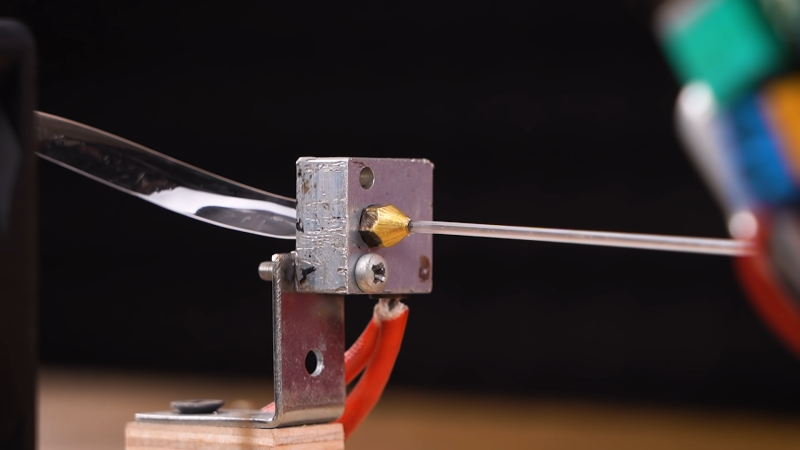Clay 3d print
3D Potter - Real Clay 3D Ceramic Printers
Our line of 3D Clay printers have some unique features when compared to other 3D printers. We use a cardinal axis system, rather than a delta printer configuration. This allows for precise control with minimal effort. Most clay printers use a pressurized system using compressed air, with a 3D Potterbot a high-pressure system is not needed.Great entry-level printer
More info
10 Proreliable and accurate
More info
Full size, Full control
More info
3D Printing Cement is here! We have combined our Scara Elite and Small 50 pump with Sikacrete® 3D printer cement developed by Sika USA. This is a versatile and convenient way of printing large-scale architecture and structures.
The Scara Elite is the first viable large-scale ceramic 3D printer using 3D printing material. It is capable of printing multiple objects non-stop. The Elite with the Small 50 can pump up to 3.5 gallons of material per minute through 85 feet of 1″ hose.
They work together so well, we decided to make them a package.
The possibilities are endless!
PR Articles/Videos
View this post on Instagram
A post shared by Hybrid Objects (@hybrid.obj) featuring non-planar printing.
View this post on Instagram
A post shared by Arina Erdélyi (@arinaerdeyli) featuring a print taken to new heights.
View this post on Instagram
A post shared by Atlas of Lost Finds (@atlas_of_lost_finds) featuring large-scale printing.
See More
3D Potter is proud to offer assembly tutorials and troubleshooting videos for our printers. Our printers can be used with Potterware, a beginner-friendly program to design pots and vases of all shapes, sizes, and patterns. Check out our Youtube channels to see our videos!
Check out our Youtube channels to see our videos!Assembly Videos
Main Channel
3D Potter accepts payment of Bitcoin (BTC) for our products. If you wish to pay by BTC, please contact us.bitcoincash:qr5wmqhnylzr0hcewfrla852xxy9zhp94uugrxy9ay
Here at 3D Potter, we like forward-thinking and preserving the environment. Tesla vehicles are a great example of both. So, if you plan on purchasing a Tesla, use our referral code at checkout and you will receive a discount and charging miles.https://www.tesla.com/referral/dan47410
3D Potterbot Scara V4 Ceramic 3D Clay Printer — Real Clay 3D Ceramic Printer
The Scara V4 is the first viable large-scale ceramic 3D printer using real clay.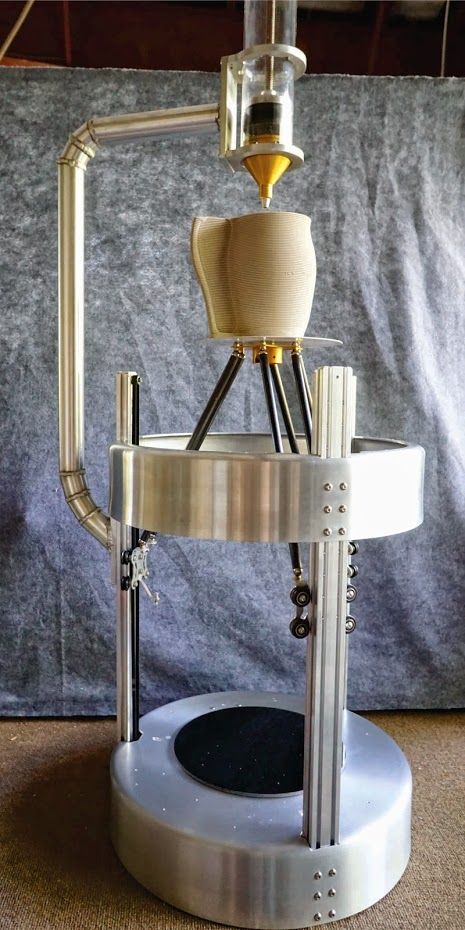 The advanced design and substantial construction can take on board loads like the 3D Potter 4000ml clay extruder.
The advanced design and substantial construction can take on board loads like the 3D Potter 4000ml clay extruder.
1. Scara v4
2. Closed loop stepper on X, Y, Z, extruder
3. Extruder size of your choice.
4. 5 anodized aluminum nozzles (standard sizes: 3, 4, 5, 6, and 8mm when extruder is purchased)
5. Parts Box: Alan key set, grease, Acme driver tool, tie wraps, extra screws
6. Power Supply
SpecificationsPrinting Envelope:
X/Y- 72" Diameter Circle (1829mm)
Z- 45” (1143mm)
Minimum Printing Envelope:
X/Y- 22" Diameter Circle (558mm)
Printer size:
W-34” L-18” H-44”
Normal operational space needed: W-40” L-36” H-~70”
Maximum operational space needed: W-88” L-88” H-~84”
Height to the top of the extruder fully extended is H~84” (2134mm)
Weight with extruder: 90 lbs. (41kg)
(41kg)
Average speed: 1.2’’ to 3.9’’/s (30 to 100 mm/s)
Power Supply: Output - 24V ~15 amps, Input - 110-220V, 50-60 Hertz.
Power consumption: 24V ~8 amps, ~192 Watt
Main controller board running Duet3D with Atmel SAM4E8E: 120MHz ARM Cortex-M4
Full control through web interface, no apps or software installation. Non-WiFi versions are available, please contact us if you would like this type of connection (Ethernet connection).
* http://www.igus.com
Some components may be re-manufactured
** https://en.wikipedia.org/wiki/Harmonic_drive
Duet Web Control is a fully developed UI for the Scara. Opened in a web browser, it can be used on your laptop, tablet, phone, or other WiFi capable device.
Print StatusOnce a print is started, it shows information about the model being printed. Layer times, estimated time remaining, file information, and more are available for view. It also allows for print and extrusion speed control to be adjusted in real time.
Layer times, estimated time remaining, file information, and more are available for view. It also allows for print and extrusion speed control to be adjusted in real time.
The G-Code Files page allows g-code files for printing to be uploaded, edited, or downloaded. A summary of the file is given such as size, layer height, and what the file was generated by.
Software requirementsNone! The only requirements is a web browser interface.
For object generation, the Scara V4 is similar to the rest of the 3D Potter line ceramic printers. It's is just like any other 3D printer which requires an STL file to be sliced by a third-party program. We recommend Simplify3D or Cura, and then loading the file to the SD card in the printer, which can be done over WiFi.
Build envelope
The build envelope diagrams represent the 45 in Z height.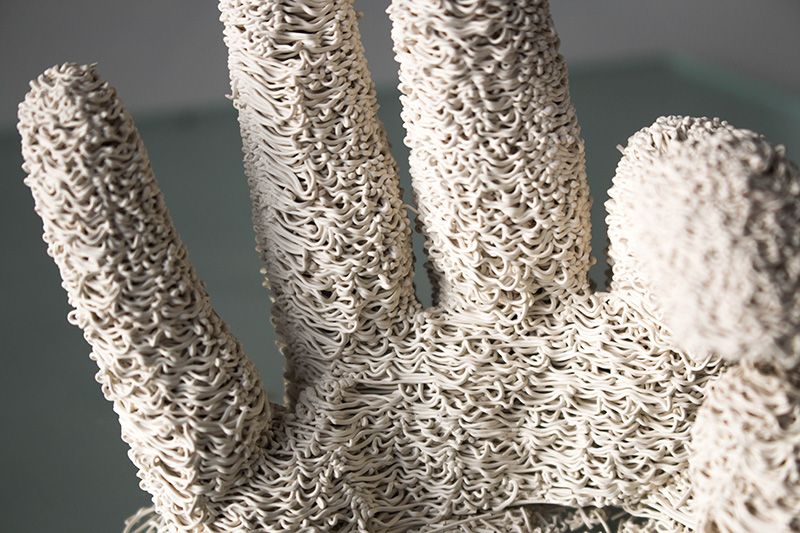 We can do custom Z heights up to 9 feet and diameters up to 8.5 feet.
We can do custom Z heights up to 9 feet and diameters up to 8.5 feet.
The Scara V4 build envelope is quite unique because it's capable of printing 360 degrees with continuous rotation. This means you can create a huge vessel with the printer initially residing inside the vessel or structure. This opens up a whole another opportunity to print small habitat structures (houses). Larger printers are available for this potential habitat project.
Another unique ability is printing multiple objects within the specified envelope in a sequential mode. For instance you could print a particular vessel starting on the far left side and continue to print these vessels until there is no more space left.
Speed and noiseThe Scara V4 is capable of extreme speeds however speed is relative when it comes to ceramic 3D printing. Realistically you probably don't want to exceed 130 mm/s. There are many factors which determine the speed like nozzle size, layer height, and achieving a good adhesion on interlayer of the clay.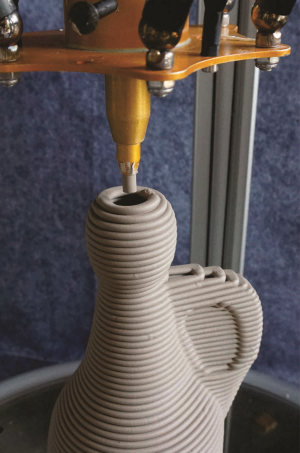
The Scara V4 is very quiet, so it can be operated in any area without disturbing the surrounding environment.
Construction and designWe were able to achieve high precision and accuracy with this large Scara arm robot only through diligent design and robust construction techniques. The majority of this structure is out of heavy aircraft grade 6061 aluminum utilizing CNC and welded components for maximum strength and rigidity. The main rail components are from IGUS* which is one of the leading German manufacturers of precision guide rails. The drive motors consist of very sophisticated hybrid closed-loop stepper motors. These have on-board computers with telemetry that continually update their position for zero error positioning.
Drive mechanismsThis is no souped-up 3D printer, this is a dedicated heavy duty purpose-built robot. The main drives are sophisticated harmonic drive units**. These are the same drives used on large industrial robots similar to the ones that are now in most of the large manufacturing facilities.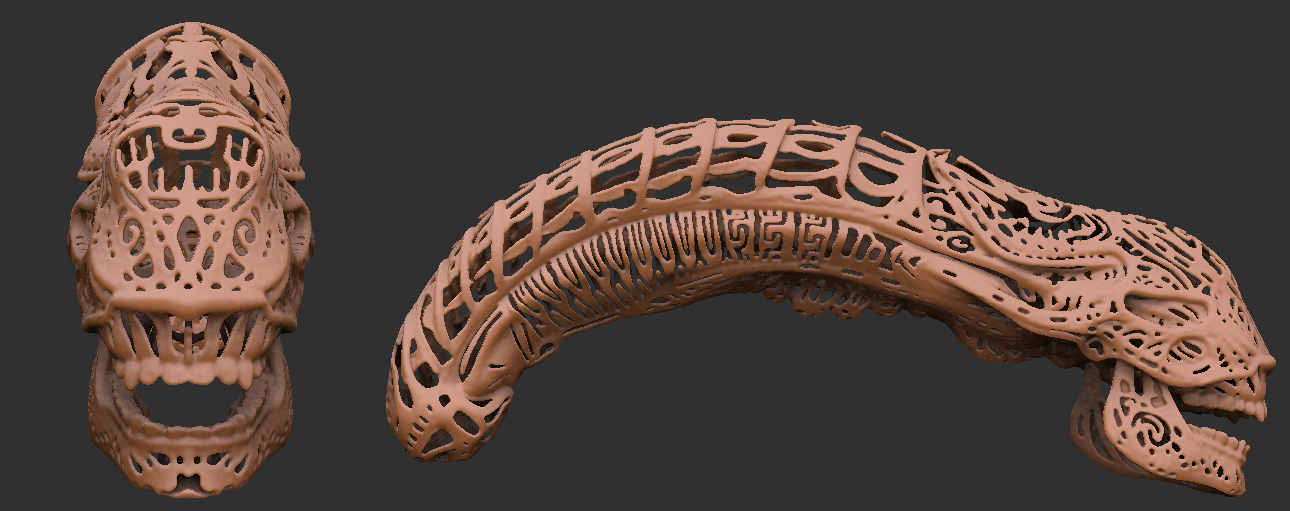 These drives are extremely heavy duty and capable of precision movement down into the fractions of a second of a degree. This means very precise prints with no backlash or jittery movements at realistic speeds. These drives are designed for maximum rigidity with extreme accuracy.
These drives are extremely heavy duty and capable of precision movement down into the fractions of a second of a degree. This means very precise prints with no backlash or jittery movements at realistic speeds. These drives are designed for maximum rigidity with extreme accuracy.
The real advantage is this machine can be positioned on a substantial table top and you can start printing right away within a limited envelope area. Or you can give it its own dedicated space for partial or full envelope.
The space needed is really determined by the end-user and how much of the print envelope they choose to use. Whether on the table top or on the floor, the Scara V4 will require direct mounting for maximum stability. This is achieved with multiple screws to secure the printer to the surface it is on. If you choose to use a tabletop it must be of substantial construction, the minimum is 1.5" thick heavy plywood or wood construction. If a inadequate table is used, the results from the printer will be diminished depending on the build envelope and speed at which the prints are created with.
Clay 3D printer Most likely, you will think about plastic. Someone might have heard about metal powders, gypsum, wax... It was a discovery for me that clay can be used for 3D printing.
1652 views
In fact, this is not a new invention, more than one company is engaged in the production of 3D printers for printing from clay. Here I want to talk about the Cerambot Eazao printer from Cerambot. I found this project on the Kickstarter crowdfunding platform. nine0003
Retrieved from https://www.kickstarter.com/
Why clay?
Clay is an environmentally friendly, accessible and cheap material. Sculptures, pots, dishes are made from it. Unlike plastic, clay does not pollute the environment and is safe for health. Clay products are easy to recycle and reuse, just soak the product in water.
In order for the printed product to be of good quality, it is important to achieve the correct consistency when kneading the clay.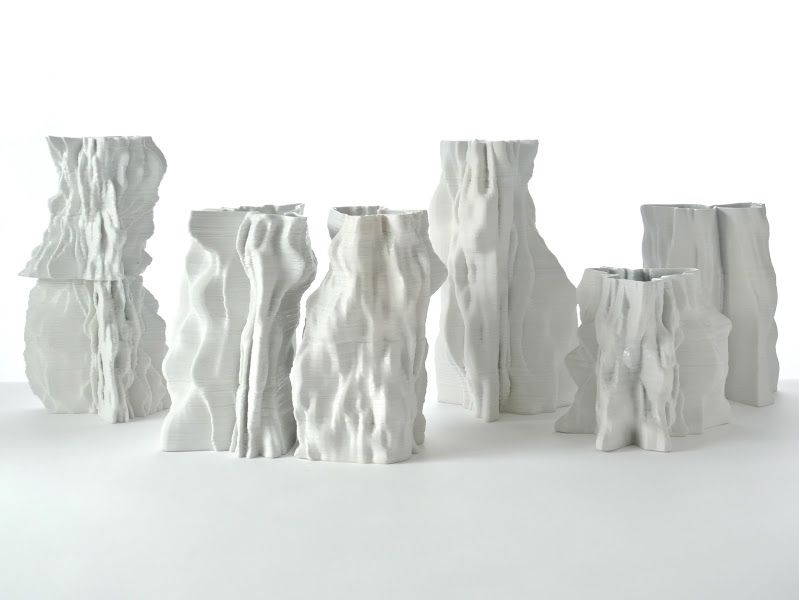 Clay should be elastic, not too hard and not too soft. It should not stick to your hands and crack when squeezed. nine0003
Clay should be elastic, not too hard and not too soft. It should not stick to your hands and crack when squeezed. nine0003
Source https://cute4home.ru
About the printer
Cerambot Eazao is designed for home use. It comes pre-assembled, so it's ready to go right out of the box. All you need to do is fill the cartridge with clay and start printing.
Retrieved from https://www.kickstarter.com/
The maximum printing speed of Cerambot Eazao is 40 mm/s. The thickness of the layers is set by different nozzles and varies from 0.8 to 2 mm. After printing, the clay remains soft and pliable for some time, so you can correct the shape of the product and eliminate imperfections. nine0003
This is the second model of a 3D printer from Cerambot. The first project raised $286,000 on Kickstarter from 1,000 sponsors.
In the second model, the developers took into account the wishes of users, improved their product and added a clay kiln to the kit.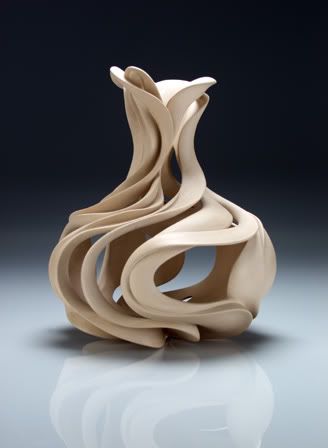
The furnace allows you to fire products at high temperatures at home without the use of specialized furnaces. It consists of a heat-resistant heat-insulating material - ceramic fiber and a high-temperature absorbing material - silicon carbide. Inside there is a cavity for the finished product. nine0003
Retrieved from https://www.eazao.com
Kiln principle
The firing process takes 35 minutes. It is necessary to place the oven with the product inside in a household microwave oven with a power of 1500 W and turn it on at maximum power.
Microwaves penetrate alumina and silica ceramic fiber. Silicon carbide absorbs microwaves and converts them into heat. The temperature in the cavity of the furnace, where the product is located, rises. Since silicon carbide is insulated and resistant to high temperatures, the temperature continues to rise and reaches the firing temperature of handmade ceramics. nine0003
After firing, wait until the oven has cooled down before removing the finished product.
Price
The price of the printer depends on the configuration. For one printer, manufacturers ask for $ 450, for a set with an oven - more than $ 500. In my opinion, this is a pretty high price for a home 3D printer. What do you think?
Other cool Kickstarter finds:
3D printed clay - LDM technology makes it easy! nine0001
Feb122016
3D printing clay
The use of ceramic materials as raw materials for 3D printing is a growing trend due to the possibility of forming objects that are almost impossible to reproduce using traditional methods. 3D clay printing provides ceramists with completely new ways to create amazing pieces. After all, thanks to the preliminary construction of a 3D model, it becomes possible to bypass many difficulties in the practical manufacture of a product. nine0003
3D printing clay
But, unfortunately, 3D printing with clay is not yet a perfect process. It contains some risks, problems and limitations that cannot be encountered in the most used production technologies.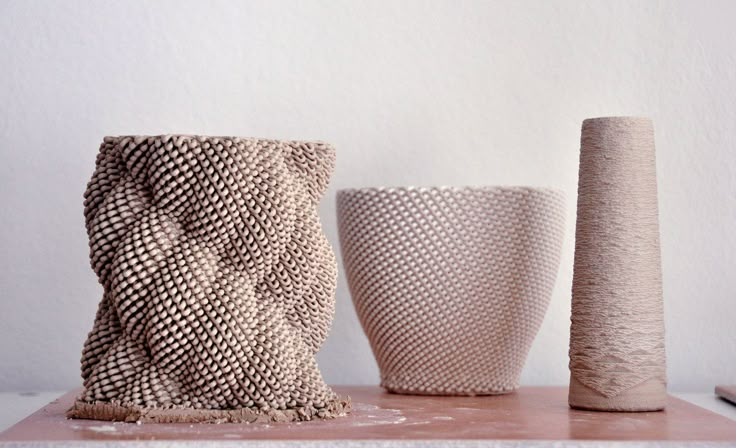 The reason for this is the peculiar features of the clay material, such as excessive softness and the length of time required for drying. Many objects are in danger of shrinking or cracking before they are fired. Also, 3D printing with clay implies significant limitations in geometry. The reason lies in the use of auxiliary materials that are not suitable for clay raw materials. And this can lead to the destruction of printed objects. nine0003
The reason for this is the peculiar features of the clay material, such as excessive softness and the length of time required for drying. Many objects are in danger of shrinking or cracking before they are fired. Also, 3D printing with clay implies significant limitations in geometry. The reason lies in the use of auxiliary materials that are not suitable for clay raw materials. And this can lead to the destruction of printed objects. nine0003
3D printing clay
Printing clay on a 3D printer
Italian 3D printer company WASP has developed a new LDM (Liquid Deposition Modeling) technology. Printing with clay on a 3D printer is very easy. The technique of liquid clay application (literally translated) solves many of the technical problems associated with printing from clay materials. However, some difficulties remain to be overcome.
3D clay printing using LDM technology allows you to tightly control the flow of clay material fed to the extruder. The process is strictly synchronized with the stepper motor, which guarantees a consistent material feed. This prevents the formation of air bubbles, deformations and other flaws that can eventually cause the destruction of ceramic products. nine0003
This prevents the formation of air bubbles, deformations and other flaws that can eventually cause the destruction of ceramic products. nine0003
3D printing clay
The firm has high hopes of collaborating with 3D ceramic artist and educator Francesco Pacelli to find out why some of the finished models get damaged and how this can be prevented. For some time now, he has been testing the capabilities of a Delta Style WASP 3D printer equipped with their LDM extruder and showing off some of the amazing ceramic designs he has modeled. According to Pacelli, the clay substance itself, and the way it is processed and mixed, is the key to developing the right technology for printing with these materials. nine0003
3D printing clay
Clay on a 3D printer
Of course, not every material is suitable for such a job. 3D printing with clay is unusual. Accordingly, clay on a 3D printer should be unusual. The artist is exploring different types of ceramics to expand the amount of raw clay available for 3D printing.







